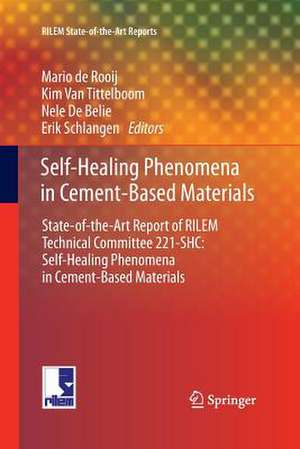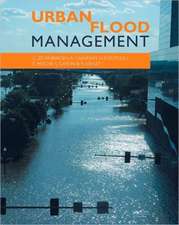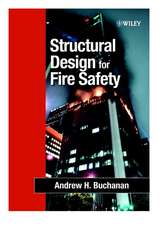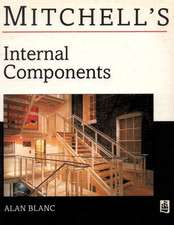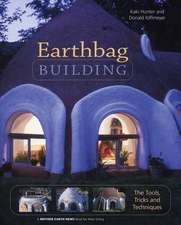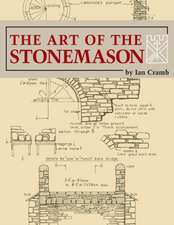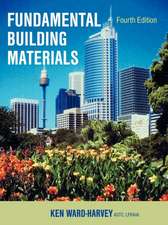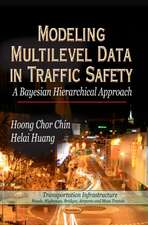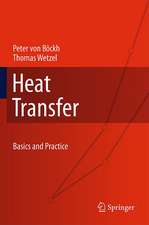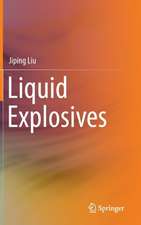Self-Healing Phenomena in Cement-Based Materials: State-of-the-Art Report of RILEM Technical Committee 221-SHC: Self-Healing Phenomena in Cement-Based Materials: RILEM State-of-the-Art Reports, cartea 11
Editat de Mario de Rooij, Kim Van Tittelboom, Nele De Belie, Erik Schlangenen Limba Engleză Paperback – 16 mai 2015
Thus far, the self-healing capacity of cement-based materials has been considered as something "extra". This could be called passive self-healing, since it was not a designed feature of the material, but an inherent property of it. Centuries-old buildings have been said to have survived these centuries because of the inherent self-healing capacity of the binders used for cementing building blocks together.
In this State-of-the-Art Report a closer look is taken at self-healing phenomena in cement-based materials. It is shown what options are available to design for this effect rather than have it occur as a "coincidental extra".
| Toate formatele și edițiile | Preț | Express |
|---|---|---|
| Paperback (1) | 640.06 lei 6-8 săpt. | |
| SPRINGER NETHERLANDS – 16 mai 2015 | 640.06 lei 6-8 săpt. | |
| Hardback (1) | 644.95 lei 6-8 săpt. | |
| SPRINGER NETHERLANDS – 4 mai 2013 | 644.95 lei 6-8 săpt. |
Din seria RILEM State-of-the-Art Reports
- 15%
 Preț: 643.84 lei
Preț: 643.84 lei - 15%
 Preț: 659.20 lei
Preț: 659.20 lei - 15%
 Preț: 644.18 lei
Preț: 644.18 lei - 15%
 Preț: 637.59 lei
Preț: 637.59 lei - 18%
 Preț: 726.34 lei
Preț: 726.34 lei - 18%
 Preț: 947.50 lei
Preț: 947.50 lei - 20%
 Preț: 565.31 lei
Preț: 565.31 lei - 18%
 Preț: 788.54 lei
Preț: 788.54 lei - 18%
 Preț: 884.22 lei
Preț: 884.22 lei - 18%
 Preț: 953.65 lei
Preț: 953.65 lei - 18%
 Preț: 967.08 lei
Preț: 967.08 lei - 15%
 Preț: 631.07 lei
Preț: 631.07 lei - 18%
 Preț: 1227.99 lei
Preț: 1227.99 lei - 15%
 Preț: 644.95 lei
Preț: 644.95 lei - 15%
 Preț: 640.24 lei
Preț: 640.24 lei - 15%
 Preț: 637.46 lei
Preț: 637.46 lei - 20%
 Preț: 589.83 lei
Preț: 589.83 lei - 15%
 Preț: 634.68 lei
Preț: 634.68 lei - 18%
 Preț: 1114.02 lei
Preț: 1114.02 lei - 18%
 Preț: 1115.28 lei
Preț: 1115.28 lei - 18%
 Preț: 950.96 lei
Preț: 950.96 lei - 18%
 Preț: 1120.81 lei
Preț: 1120.81 lei - 18%
 Preț: 894.34 lei
Preț: 894.34 lei - 20%
 Preț: 554.90 lei
Preț: 554.90 lei - 15%
 Preț: 635.65 lei
Preț: 635.65 lei - 15%
 Preț: 713.02 lei
Preț: 713.02 lei - 15%
 Preț: 645.79 lei
Preț: 645.79 lei - 15%
 Preț: 583.78 lei
Preț: 583.78 lei - 15%
 Preț: 528.48 lei
Preț: 528.48 lei
Preț: 640.06 lei
Preț vechi: 753.01 lei
-15% Nou
Puncte Express: 960
Preț estimativ în valută:
122.51€ • 127.41$ • 102.66£
122.51€ • 127.41$ • 102.66£
Carte tipărită la comandă
Livrare economică 13-27 martie
Preluare comenzi: 021 569.72.76
Specificații
ISBN-13: 9789400799929
ISBN-10: 9400799926
Pagini: 288
Ilustrații: XX, 266 p.
Dimensiuni: 155 x 235 x 15 mm
Greutate: 0.41 kg
Ediția:2013
Editura: SPRINGER NETHERLANDS
Colecția Springer
Seria RILEM State-of-the-Art Reports
Locul publicării:Dordrecht, Netherlands
ISBN-10: 9400799926
Pagini: 288
Ilustrații: XX, 266 p.
Dimensiuni: 155 x 235 x 15 mm
Greutate: 0.41 kg
Ediția:2013
Editura: SPRINGER NETHERLANDS
Colecția Springer
Seria RILEM State-of-the-Art Reports
Locul publicării:Dordrecht, Netherlands
Cuprins
1 Introduction: 1.1 Self-healing phenomena.- 1.2 Why self-healing in cement-based materials.- 1.3 Definitions in an emerging field.- 1.4 Outline of the report.- 1.5 Link to other RILEM TC’s.- 1.6 References.- 2 Experimental techniques used to verify healing: 2.1 Introduction.- 2.2 Techniques used to examine crack healing.- 2.3 Techniques used to verify recovery against environmental actions.- 2.4 Techniques used to verify recovery against mechanical actions.- 2.5 References.- 3 Recovery against environmental action: 3.1 Autogenic self-healing.- 3.2 Autonomic self-healing.- 3.3 References.- 4 Recovery against mechanical actions: 4.1 Autogenic self-healing.- 4.2 Autonomic self-healing.- 4.3 References.- 5 Modelling of self-healing cementitious materials: 5.1 Introduction.- 5.2 Lattice modelling for concrete with tubular encapsulation.- 5.3 Simulation of autogenic self-healing for concrete at early age.- 5.4 Simulation of self-healing capacity of hybrid fibre material.- 5.5 Analyticalmodels for cracks hitting encapsulated materials.- 5.6 Self-healing by on-going hydration.- 5.7 References.- 6 Other materials, applications and future developments: 6.1 Introduction.- 6.2 Self-healing in other materials.- 6.3 Applications.- 6.4 Future developments and outlook.- 6.5 References.
Textul de pe ultima copertă
Self-healing materials are man-made materials which have the built-in capability to repair damage. Failure in materials is often caused by the occurrence of small microcracks throughout the material. In self-healing materials phenomena are triggered to counteract these microcracks. These processes are ideally triggered by the occurrence of damage itself.
Thus far, the self-healing capacity of cement-based materials has been considered as something "extra". This could be called passive self-healing, since it was not a designed feature of the material, but an inherent property of it. Centuries-old buildings have been said to have survived these centuries because of the inherent self-healing capacity of the binders used for cementing building blocks together.
In this State-of-the-Art Report a closer look is taken at self-healing phenomena in cement-based materials. It is shown what options are available to design for this effect rather than have it occur as a "coincidental extra".
Thus far, the self-healing capacity of cement-based materials has been considered as something "extra". This could be called passive self-healing, since it was not a designed feature of the material, but an inherent property of it. Centuries-old buildings have been said to have survived these centuries because of the inherent self-healing capacity of the binders used for cementing building blocks together.
In this State-of-the-Art Report a closer look is taken at self-healing phenomena in cement-based materials. It is shown what options are available to design for this effect rather than have it occur as a "coincidental extra".
Caracteristici
First publication of this kind on self-healing phenomena in cement-based materials Valuable new insights on dealing with damage in repair and maintenance issues of civil engineering structures Latest state-of-the-art research collected on the topic in just one book
